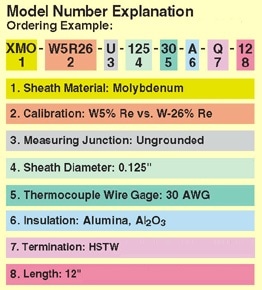The OMEGA® Exotic Thermocouple Probes are built for use in extreme temperatures - up to 2315 °C (4200 °F). These probes utilize either tungsten/rhenium (types G, C, or D) or platinum/rhodium (types R, S, or B) elements, with various insulations and sheath materials.
Based on the sheath material chosen, these probes may be used in oxidizing, inert, reducing, or vacuum conditions. The highest temperature is based on the lowest maximum temperature of the element, sheath, and insulation material.
Five cold end probe terminations are available – subminiature or standard size ceramic connector, replacement probe, molybdenum-sheathed nylon connector, heavy-duty standard size, or transition joint with two-meter long lead wire.
- Sheaths – Tantalum, molybdenum, Inconel 600, and platinum/rhodium
- Thermocouple elements – Tungsten/rhenium, and platinum/rhodium
- Insulations – Hafnium oxide (HfO2), magnesia (MgO), and alumina (Al2O3)
Sheath Materials
| Code |
Material |
Max. Operating Temp. |
Working Environment |
Approx. Melting Point |
Remarks |
| XTA |
Tantalum |
2300 °C
4200 °F |
Vacuum |
3000 °C
5425 °F |
Resists Many Acids
and Weak Alkalies.
Very Sensitive to
Oxidation Above 300 °C |
| XMO* |
Molybdenum |
2200 °C
4000 °F |
Inert
Vacuum
Reducing |
2610 °C
4730 °F |
Sensitive to Oxidation
Above 200 °C
Non-bendable |
| XPA |
Platinum-
Rhodium
Alloy |
1650 °C
3000 °F |
Oxidizing
Inert |
1870 °C
3400 °F |
No Attack by SO2
at 1100 °C. Silica Is
Detrimental. Halogens
Attack at High Temp. |
| XIN |
Inconel
600 |
1150 °C
2100 °F |
Oxidizing
Inert
Vacuum |
1400 °C
2550 °F |
Excellent Resistance
to Oxidation at High
Temp. Hydrogen Tends
to Embrittle. Very
Sensitive to Sulphur
Corrosion |
*Refractory metals are highly sensitive to any trace of oxygen above roughly 260 °C (500 °F). Should be used in vacuum or in very pure inert gases such as argon or helium.
Insulation Materials
| Code |
Material |
Max. Operating Temp.** |
Approx. Melting Point |
Remarks |
| H |
Hafnia
(HfO2) |
2500 °C
4530 °F |
2830 °C
5125 °F |
Nontoxic substitute for BeO.
High Thermal Conductivity. |
| M |
Magnesia
(MgO) |
1650 °C
3000 °F |
2790 °C
5050 °F |
Hygroscopic.
Compacts Well. |
| A |
Alumina
(Al2O3) |
1540 °C
2800 °F |
2010 °C
3650 °F |
Requires Considerable
Volume Reduction to
Compact Satisfactorily. |
Note:
For temperatures over 1000 °C (1800 °F), all insulating materials undergo a considerable decrease in resistivity with increasing temperatures.
** Values provided are for compacted insulation. For uncompacted hard-fired insulators, practical temperature range can be 40 to 90 °C (100 to 200 °F) higher.
It is advised not to use molybdenum sheathed probes in applications where they might come into contact with carbon, including graphite.
Termination Style Q
Type OGP heavy-duty, color-coded male and female connectors.
Termination Style HX
Type NHX high temperature ceramic male and female connectors with color identification dot.
Termination Style RP
Replacement probe style with 25 mm long bare wire leads.
Termination Style SX
Type SHX tiny high temperature ceramic male and female connectors with color identification dot.
Termination Style TJ
Heavy-duty transition termination with 2-meter long leads.
| Calibration1 |
Atmosphere2
Max.Temp3 |
Model Number |
C
W-5% Re
vs. W-26% Re |
V.
2300 °C
4200 °F |
XTA-W5R26-U-062-30-H-*-**
XTA-W5R26-U-125-30-H-*-**
XTA-W5R26-U-125-24-H-*-** |
R*
Pt-13% Rh
vs. Pt |
V.
1475 °C
2700 °F |
XTA-P13R-U-062-30-M-*-**
XTA-P13R-U-125-24-M-*-**
XTA-P13R-U-062-30-H-*-**
XTA-P13R-U-125-24-H-*-** |
C
W-5% Re
vs. W-26% Re |
I.V.R.
2200 °C
4000 °F |
XMO-W5R26-U-125-30-H-*-**
XMO-W5R26-U-250-30-H-*-** |
C
W-5% Re
vs.W-26% Re |
I.V.R.
1540 °C
2800 °F |
XMO-W5R26-U-250-30-A-*-**
XMO-W5R26-U-062-40-A-*-**
XMO-W5R26-U-125-30-A-*-** |
R*
Pt-13% Rh
vs. Pt |
I.V.R.
1480 °C
2700 °F |
XMO-P13R-U-125-30-A-*-**
XMO-P13R-U-250-24-A-*-** |
C
W-5% Re
vs. W-26% Re |
O.I.V.
1540 °C
2800 °F |
XPA-W5R26-U-125-30-A-*-** |
R*
Pt-13% Rh
vs. Pt |
O.I.V.
1480 °C
2700 °F |
XPA-P13R-U-062-30-M-*-**
XPA-P13R-U-125-24-M-*-**
XPA-P13R-U-125-30-A-*-** |
C
W-5% Re
vs. W-26% Re |
O.I.V.
1150 °C
2100 °F |
XIN-W5R26-U-062-30-M-*-**
XIN-W5R26-U-125-30-M-*-** |
R*
Pt-13% Rh
vs. Pt |
O.I.V.
870 °C
1600 °F |
XIN-P13R-U-062-30-M-*-**
XIN-P13R-U-125-30-M-*-**
XIN-P13R-U-125-24-M-*-**
XIN-P13R-U-187-26-M-*-**
XIN-P13R-U-250-24-M-*-**
XIN- P13R-U-250-20-M-*-** |
* Specify Termination Style: Q, TJ, HX, SX, or RP
** Specify Probe Length in inches

Note 1: Prices subject to change; Please consult the Sales - Department for current pricing.
Note 2: Atmospheres: O-Oxidizing; I-Inert; V-Vacuum; R-Reducing.
Note 3: Maximum service temperatures shown are for probes with the largest available gauge wire leads. Consult engineering for ratings of other dimension probes.
Note 4: Bending: XPA and XIN sheathed probes with platinum elements be bent in the field.
Note 5: Some probes available in dual configurations. Check with sales department.